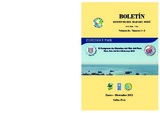Por favor, use este identificador para citar o enlazar este ítem:
https://hdl.handle.net/20.500.12958/2163| Título : | Sedimentos marinos superficiales del litoral de Tacna, Perú, 2004 |
| Otros títulos : | Shallow marine sediments off the coast of Tacna, Perú, 2004 |
| Autor : | Velazco Castillo, Federico Solís Acosta, Juana Cárdenas, Fredy |
| Palabras clave : | Sedimentología;Sedimentos Marinos;Fondo Marino |
| Fecha de publicación : | 2011 |
| Editorial : | Instituto del Mar del Perú |
| Citación : | Bol Inst Mar Perú 26(1-2), 2011: p. 83-91 |
| Citación : | Boletín;vol. 26(1-2), 2011 |
| Resumen : | Los sedimentos submarinos colectados a fines de setiembre 2004 a profundidades <50 m, al sur de la desembocadura del río Sama (18°10’S), fueron predominantemente arenosos (>60%). El mayor contenido de la fracción fina, de limo y arcilla (±35%), se ubicó en las zonas más profundas del área en estudio y en los extremos norte (frente a Cerro Cortado) y al sur (Los Palos), que incluyen también zonas de menor profundidad. En la zona central, la pendiente tiene la mayor inclinación de toda la zona estudiada, y el tamaño promedio del grano del sedimento es más grande; estas condiciones constituyen un reflejo de la mayor energía hidrodinámica que existe. En la zona central también se observa la típica disminución del tamaño de grano, según se incrementa la profundidad y la lejanía de la línea de costa. La distribución de materia orgánica
mostró tendencia similar a la de fracción fina, con un máximo de 5,02%. ABSTRACT: The marine sediments collected in late September 2004 at depths <50 m south of the mouth of the river Sama (18°10’S), were predominantly sandy (>60 %). The highest content of the fine fraction, silt and clay (±35%), was located in the deepest parts of the study area and in the extreme north (off Cerro Cortado) and south (Los Palos), including also shallower areas. In the central area, the slope is steeper throughout the study area, and the average grain size is larger sediment; these conditions are a reflection of the higher hydrodynamic energy that exists. In the central area there is also the typical grain size decreased as the depth increases and the distance from the coastline. The distribution of organic matter showed a trend similar to the fine fraction, with a maximum of 5.02% |
| Descripción : | Boletín IMARPE vol. 26, nº 1-2, 2011; p. 83-91 |
| URI : | https://hdl.handle.net/20.500.12958/2163 |
| ISSN : | 0458 - 7766 |
| Aparece en las colecciones: | Boletín 26(1-2), 2011 |
Ficheros en este ítem:
| Fichero | Descripción | Tamaño | Formato | |
|---|---|---|---|---|
| Bol. vol. 26-10.pdf | 1,82 MB | Adobe PDF |  Visualizar/Abrir |
Este ítem está sujeto a una licencia Creative Commons Licencia Creative Commons

